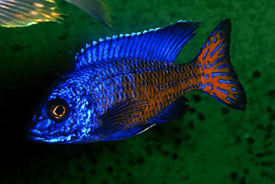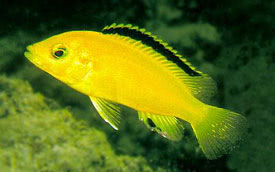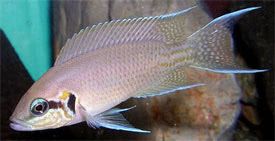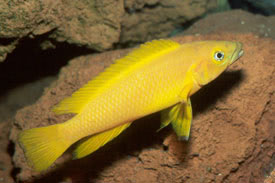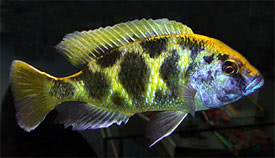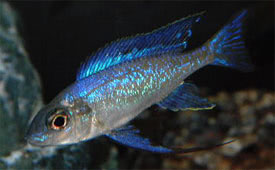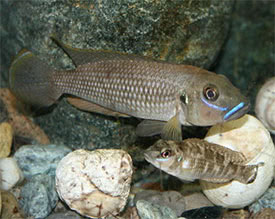
 Magyarul / Hungarian
Magyarul / Hungarian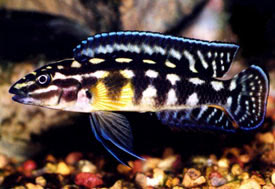
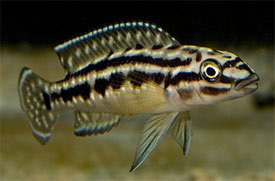

- Scientific name: Julidochromis marlieri
- Common name: Checkerboard Julie, Marlier's Julie
- Group: Cichlids
- Habitat: Africa; Lake Tanganyika
- Size: 12-13 cm.
- Biotope: Found along the southwestern rocky shores of Lake Tanganyika.
- Social behavior: A fish territorial towards others of its own species. Compatible pairs are hard to come by as they often will not be able to find a mate. Like other Julidochromis, J. marlieri can be combined with other robust Lake Tanganyika cichlids and catfish. Once a pair forms, it is usually unstable. The bond can easily be broken by a sudden change in the water conditions or a tank rearrangement.
- Diet: Live, crustaceans, bloodworms, other insect larvae, aquatic insects, Tubifex, finely chopped meat, flakes, pellets, spinach.
- Breeding: Very easy
- Tank: Minimum 100 litres
- Population: 1 pair for 100 litres
- Decoration: The tank should have a rocky set-up including caves and crevices. Use a fine gravel or preferably, a coral sand substrate. Cover the tank well, as frightened fish may be inclined to leap. A few hardy plants can be used. The rearrangement of the tank can lead to the break-up of pair bonds.
- Temperature: 25-26°C
- pH: 7.5-9.5
- Hardness: 10-25 NK°
- Lifespan: 5-8 years
Description: A fish similar in body shape to J. ornatus, although adults develop a hump on their forehead, and the lips are of their mouth are considerably larger. The caudal fin is fan-shaped. The background color is generally beige to a dull yellow-gold, with three to four brown-black lateral stripes. Crossing these stripes are five to eight faint, brown transverse bars, that together form a "Checkerboard" pattern. All these stripes and bars vary in intensity and size depending on the individual. The fins have a brown-black background and are spotted with small, yellow dots. The caudal fin includes a white line that follows the edge of this fin.
Males are smaller and when mature its genital papilla comes to a point and is aimed toward the tail. With the female, the genital papilla is rounded and points toward the head.
To achieve success in spawning Julidochromis species, one must first obtain a compatible pair. For details please see the "Breeding of Cavity Brooders" in the introduction of Lake Tanganyika Cichlids. A small, 24" (60 cm) or 15 gallons (56 L) tank can be used. It should be arranged with caves and other rock structures. The water should be alkaline with a pH from 8.2-9.0, have a water hardness from 12-20 dH, and a temperature from 75-81°F (24-27°C). Keep a single pair in the breeding tank. The female deposits up to 100, although more often 10-40, eggs on the ceiling of a chosen cave. There the eggs are fertilized by the male. Often these proceedings can go unnoticed by the aquariast as they usually take place deep in the cave. The fry are very small, usually about 0.2" (0.5 cm) in length. They adhere to the ceiling or sides of the cave for 5-6 days. When the young are free-swimming they remain in the parent's territory under their indirect care. Start feeding with Artemia nauplii, Cyclops nauplii, and later with crushed dry foods. The pair will spawn continuously and receive aide in caring for the eggs from the offspring of prior spawnings.





